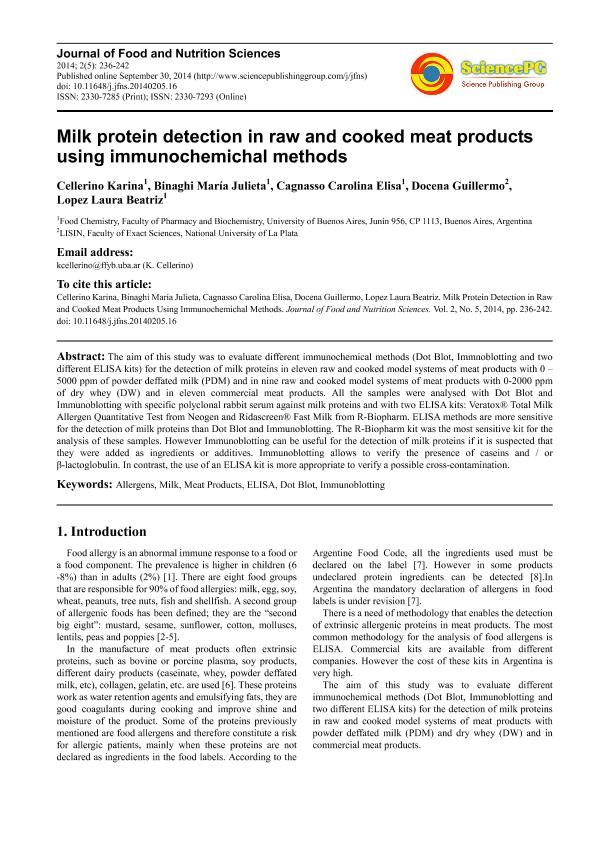Artículo
Milk Protein Detection in Raw and Cooked Meat Products Using Immunochemichal Methods
Cellerino, Karina ; Binaghi, Maria Julieta; Cagnasso, Carolina Elisa; Docena, Guillermo H.
; Binaghi, Maria Julieta; Cagnasso, Carolina Elisa; Docena, Guillermo H. ; Lopez, Laura Beatriz
; Lopez, Laura Beatriz
 ; Binaghi, Maria Julieta; Cagnasso, Carolina Elisa; Docena, Guillermo H.
; Binaghi, Maria Julieta; Cagnasso, Carolina Elisa; Docena, Guillermo H. ; Lopez, Laura Beatriz
; Lopez, Laura Beatriz
Fecha de publicación:
09/2014
Editorial:
Science Publishing Group
Revista:
Journal of Food and nitrition sciences
ISSN:
2330-7285
Idioma:
Inglés
Tipo de recurso:
Artículo publicado
Clasificación temática:
Resumen
The aim of this study was to evaluate different immunochemical methods (Dot Blot, Immnoblotting and two different ELISA kits) for the detection of milk proteins in eleven raw and cooked model systems of meat products with 0 – 5000 ppm of powder deffated milk (PDM) and in nine raw and cooked model systems of meat products with 0-2000 ppm of dry whey (DW) and in eleven commercial meat products. All the samples were analysed with Dot Blot and Immunoblotting with specific polyclonal rabbit serum against milk proteins and with two ELISA kits: Veratox® Total Milk Allergen Quantitative Test from Neogen and Ridascreen® Fast Milk from R-Biopharm. ELISA methods are more sensitive for the detection of milk proteins than Dot Blot and Immunoblotting. The R-Biopharm kit was the most sensitive kit for the analysis of these samples. However Immunoblotting can be useful for the detection of milk proteins if it is suspected that they were added as ingredients or additives. Immunoblotting allows to verify the presence of caseins and / or β-lactoglobulin. In contrast, the use of an ELISA kit is more appropriate to verify a possible cross-contamination.
Palabras clave:
Allergens
,
Elisa
,
Dot Blot
,
Immunoblotting
,
Meat Products
,
Milk
Archivos asociados
Licencia
Identificadores
Colecciones
Articulos(SEDE CENTRAL)
Articulos de SEDE CENTRAL
Articulos de SEDE CENTRAL
Citación
Cellerino, Karina; Binaghi, Maria Julieta; Cagnasso, Carolina Elisa; Docena, Guillermo H.; Lopez, Laura Beatriz; Milk Protein Detection in Raw and Cooked Meat Products Using Immunochemichal Methods; Science Publishing Group; Journal of Food and nitrition sciences; 2; 5; 9-2014; 236-242
Compartir



